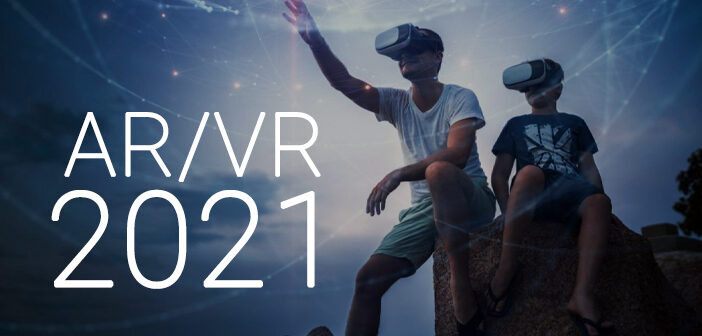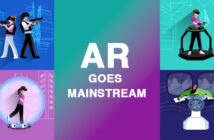Every year, innovations in the world of eXtended Reality (AR/VR) technologies reach new zeniths. The first half of 2021 has brought incredible tidings, bringing the industry ever closer to its projected value of $333 billion within this decade. Despite localized slowdowns happening across the world, tech giants like Google, Facebook, HTC, Snapchat and Apple have each unveiled products that are set to spark off significant trends in XR adoption.
Here is a look at the top 5 AR/VR additions of 2021, and why we’re excited about them!
Google’s Project Starline
Project Starline was unveiled in the Google ‘I/O’ keynote this May, a booth that takes the idea of video conferencing to the next level. With a mirror-like screen display and a barrage of cameras for 3D imaging, Project Starline makes it possible for two users to interact with each other from their respective booths via a rich and immersive interface. The quality of the virtual projection is unlike anything we have seen before.
Thanks to custom-built hardware and highly specialized equipment, the current iteration of Project Starline is restricted to Google’s own offices. Unlike the present gamut of AR/VR hardware like headsets and glasses, Project Starline trades device mobility for user immersion. According to Clay Bavor, lowering these barriers of access and expense are next on Google’s agenda, as a step towards integrating these technological leaps into their wide array of products.
HTC Vive
Since 2015, HTC has held a prominent share in the VR headset market. Yet, the high price point of its offerings hold limited appeal for consumers.
Changing tact, HTC has released two new models this year – the Vive Pro 2 for PC, and Focus 3 with enterprises in mind. Unveiled during the Vivecon 2021, the headsets captured attention with their 5k display resolution approaching the range of reality.
As businesses adapt to online remote working, maintaining employee morale is crucial to keep operations afloat. HTC is addressing this need with their latest product rollouts, offering organizations a way to make virtual offices more engaging and immersive. With a full suite of XR tools and services being launched in tandem with the headsets, the company is making a 360° push towards claiming the top spot in the mass market.
Facebook’s Oculus Rift
Facebook’s 2014 acquisition Oculus has been the dominant VR headset maker in the entertainment space. In 2021, Oculus has released an updated version of the Quest, Oculus Quest 2. Offering some of the richest VR gaming experiences ever seen, Quest 2 packs a punch with its single-panel display system running at 120hz.
Quest 2 is ergonomically designed – wireless, 10% lighter than its predecessor, with a longer battery life and a smaller price tag. These improvements promise a significant rise in demand for VR tech in the mass market, where comfort and cost are deciding factors.
With the beta version of Facebook Horizon being launched last year, this year’s hardware offerings will create renewed interest in virtual commons and immersive experiences, ala Roblox.
Spectacles by Snap Inc.
While the adoption of Stories by competing platforms may have dented Snapchat’s user count temporarily, it is truly the company’s dedication to AR technology that cements its position as a perennial market force.
True to form, Snapchat launched the fourth rendition of the Spectacles last month. Snap Inc. has a clear vision for the product – to “reinvent the camera”. Spectacles build upon the graphic overlay functionality of previous product iterations, processing visual and spatial data faster than ever before thanks to the Qualcomm Snapdragon XR1 Platform.
As of now, Spectacles are only available to AR creators; this strategy of limited release is one of Team Snap’s tried and tested strategies to drum up global interest. AR spectacles have a record of being a financial burden on most businesses; Snapchat’s daring venture is a push in the direction of making the technology viable beyond creator circles, even though it will likely see little return on financial investment in the short run.
In the meanwhile, we can be sure to see platform-exclusive projects to emerge from the limited release collaborations. Spectacles may not be up for sale just yet, but they’ll impact the market all the same.
AR-enabled Apple Maps
Apple has always been on the forefront of creating the most user-friendly experiences, and their newest AR technology upgrade for maps promises to live up to that legacy. Users of the iOS 15 can get a clear view of their surroundings simply by lifting their cameras, as the AR map function creates detailed walking directions in real-time.
Combining geo-location, movement sensors, and visual scans from the camera feed, Apple’s AR map is one of the company’s few XR tools due for deployment this year. Scheduled for a release with the iPhone12, Apple Maps will add an immersive interface to one of the most useful mobile applications – GPS navigation.
In the last few years, AR tools for the mass market have primarily focused on entertainment. With its newest set of offerings, Apple can definitively shift the public’s perception of the technology towards broader adoptability.
What Next?
With every year, advancements in AR/VR get one step closer to crossing the uncanny valley and creating virtual worlds that can give reality a run for its money. As of now, mass adoption of most hardware based AR/VR experiences is restricted due to high cost of investment.
The fastest way to bridge this gap will be through platform-agnostic software that makes it possible for people to connect with each other in immersive reality.




